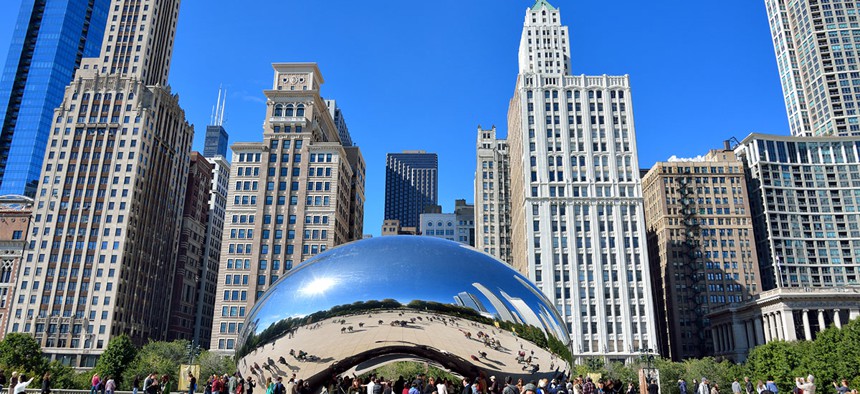Presidential Report Puts Cities at the Center of US Innovation Policy

Lucas Photo/Shutterstock.com
The new report from Obama’s science and tech advisors outlines the case for an urban-focused technology policy.
I’ve long complained that U.S. cities are not getting the attention they deserve from the federal government, even though they are the nation’s fundamental engines of innovation and economic progress. But that may be starting to change, thanks to a new report from President Obama’s high-level Council of Advisors on Science and Technology.
In the report, titled "Cities and the Future of Technology," PCAST makes the case for putting cities at the very center of America’s innovation strategy and technology policy. The report is the product of a blue-ribbon panel of the nation’s leading scientists, technologists and urbanists such as John P. Holdren (the assistant to the president for science and technology), Alphabet’s Executive Chairman Eric Schmidt, and Daniel Doctoroff, the CEO of Sidewalk Labs.
Ultimately, PCAST argues in favor of a “place-based” policy that uses investments to embed the most advanced technology in urban infrastructure. It maintains that the U.S. needs a bold new approach that goes beyond the current emphasis on smart cities.
In other words, the nation and its cities should use technology not only to upgrade and transform aging infrastructure, but to reshape the way cities operate from top to bottom. Doing so will save energy, reduce traffic and congestion, create more sustainable and competitive cities, and bolster the innovation and competitiveness of the U.S. more broadly, according to the report.
In advancing its findings, the report focuses on several dimensions of cities and technology.
Transportation: The report highlights efforts to develop driverless vehicles, or CAVs. These kinds of developments, the report argues, not only pose significant money-saving opportunities, but are also responsible for placing the nation “on the verge of large-scale transformation.”
Considering the cost of traffic collisions ($300 billion per year), vehicular congestion ($124 billion per year), and related health-care incidents ($50-80 billion per year) in the U.S., the report finds that the nation could save around $1.2 trillion per year if people refrained from driving.
Energy: From electric energy systems to electric vehicles, the increasing “electrification” of our cities is helping to protect our environment and benefit our economy in the long run, the report argues. The report also focuses on the concept of “District Energy,” which uses technology to coordinate the local production of energy with its local uses. In 2015, three cities—Burlington, Vermont; Greensburg, Kansas; and Aspen, Colorado—already declared themselves 100 percent renewable, the report finds.
Buildings and housing: While nearly 67 percent of cities worldwide have committed to green-building codes, only 12 U.S. cities rank among the leading cities for environmental design. To fix this, the report recommends a number of changes, including the integration of sensory technology that understands and responds to changes in the environment.
Water: With regard to our world’s most precious resource, the report focuses on storm water systems as a means of improving water infrastructure at the local level. Over in Los Angeles, for instance, the report finds that the city could triple or even quadruple its storm-water capture by 2099 by adding these systems in households and neighborhood districts.
Factories and farms: Technology is not only transforming high-end knowledge fields, but labor-intensive fields like manufacturing and farming as well. When it comes to manufacturing, the report focuses on the need to take advantage of the growth of high-tech industries by creating jobs for low-income residents.
When it comes to urban farming, the report emphasizes the need for soil-less agriculture systems and praises the work of rooftop greenhouses in places like Brooklyn, Queens and Chicago.
Most of all, the report makes the case for stronger involvement of the federal government in the crucial nexus of cities and technology. Many have argued that cities can solve their own problems, or even that mayors should rule the world, but the report smartly recognizes that such massive investments in infrastructure need the support of the federal government.
To that end, the report makes four specific recommendations.
Invest in and experiment with technology: First, the report recommends the creation of a new Cities Innovation Technology Investment Initiative, or CITII, to coordinate city-by-city efforts and enhance urban innovation across the nation. At the outset, this initiative would select five districts—at least two of which are low-income communities—to receive $30-40 million for technology advancements.
The initiative would also designate certain federal agencies as “districts of experimentation” to test out new technologies. Finally, the report recommends that the CITII develop training and certification programs to turn new innovation into a means of job production.
Set up innovation laboratories: Next, the report recommends creating new “innovation laboratories” within the Department of Housing and Urban Development to assemble the same technological resources that many governmental agencies have already.
Focus on infrastructure and low-income communities: The report recommends that cities develop “Urban Development Districts,” which would receive funding from the Treasury to generate innovation in low-income districts. Along these same lines, the authors support the approval of public infrastructure bonds that would incentivize private investment in tech-based urban innovation.
Coordinate research: Finally, a new Urban Science Technology Initiative should be created within the National Science and Technology Council to coordinate federally funded research (both short- and long-term) across these agencies.
The report recognizes that cities are the key to both developing and deploying new technology. Just as technology led to massive advances in manufacturing—from automation and robotics to more efficient supply chains and deliveries—so too does it promise to improve the productivity of cities and urban infrastructure.
The big problem, of course, lies in our increasingly polarized and dysfunctional political system that will make it hard, if not impossible, to do the kinds of things the report outlines. Still, the report does much to show why we need to put cities at the center of our strategy for innovation and economic competitiveness.



